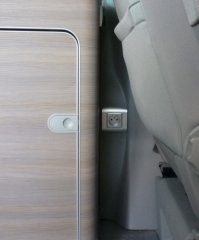2CV67
VIP Member
I only use the inverter socket (230v off leisure batteries & limited to 150W) to recharge my camera batteries, so only about once a (holiday) week & for 3 hours & low current (0.2A).
I use a proper (French) plug & use it carefully.
After 50 nights on board (maybe 7 plug-ins max) the socket contacts became very intermittent & VW replaced the socket (& the inverter to which it is apparently attached!)
It then worked perfectly but now (after 109 nights on board) it is back to intermittent.
By intermittent, I mean it depends where/how you position the plug in the socket.
It just feels as if the contacts inside the socket have lost their spring force.
VW are willing to replace the whole lot again under garantee, but we both feel this may not be a permanent solution.
They therefore suggest, and I am agreeing at the moment, replacing the socket by a normal (French) domestic 2-pin socket, surface-mounted on the sink-unit front face.
It is surprising to come to the conclusion that the original socket is not up to the job.
What is anybody else's experience?
Thanks!
I use a proper (French) plug & use it carefully.
After 50 nights on board (maybe 7 plug-ins max) the socket contacts became very intermittent & VW replaced the socket (& the inverter to which it is apparently attached!)
It then worked perfectly but now (after 109 nights on board) it is back to intermittent.
By intermittent, I mean it depends where/how you position the plug in the socket.
It just feels as if the contacts inside the socket have lost their spring force.
VW are willing to replace the whole lot again under garantee, but we both feel this may not be a permanent solution.
They therefore suggest, and I am agreeing at the moment, replacing the socket by a normal (French) domestic 2-pin socket, surface-mounted on the sink-unit front face.
It is surprising to come to the conclusion that the original socket is not up to the job.
What is anybody else's experience?
Thanks!














